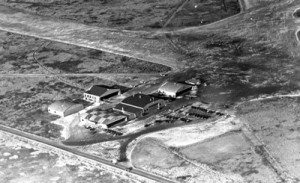Canton Airport in the Golden Age of Aviation Pt. 1
By George T. ComeauBelow is part one in a two-part series on the history of the now-defunct Canton Airport.
There are long-lost plans of men and women that, if implemented, would have changed Canton forever. The most notable of these plans was the development of the Massachusetts Air Terminal and Arena. The ambition of the men who devised the plan was to construct a major air terminal along the border of Canton and Norwood — in essence an airport that would become one of the nation’s hubs for the fledgling passenger and commercial air industry.
The public’s interest in aviation was intense; Charles Lindbergh had completed his historic solo non-stop flight across the Atlantic in 1927. Instantly famous, Lindbergh stoked the imagination of the American spirit, and people across the country would forever cast their eyes and hearts to the sky. Add to the equation Amelia Earhart, who by 1927 had already counted more than 500 hours of solo flying, and instantly both men and women could picture themselves soaring through the sky.
A small group of men gathered together to discuss the ambition for building landing fields, hangars, and assorted recreational facilities for the Massachusetts Air Terminal and Arena (MATA). In the spring of 1930 the engineering firm of Merick Widlish & Co. of Chicago began the engineering plans and study for the new airport. Merick Wildish began engineering for cities and private corporations in 1907 and specialized in community-based airfield development — they knew their stuff, and the plans showed a prescience as to how great air traffic would become in the United States. On June 16 the engineers unveiled a masterful plan that would begin the transformation of 1,298 acres from a shallow wetland of thick peat to the proposed “world-class airport.”
Investors in MATA had purchased land in the Fowl Meadows along Neponset Street and bordered by a new state superhighway off of present day Route 1. For newcomers to Canton, the airport is about to become parkland and is on the right-hand side as you leave Canton for Norwood on Neponset Street. One important feature was that the land bordered almost a mile and a half of railroad lines and proposed industrial land. The purchase, when recorded in the Dedham Registry of Deeds, was said to be the largest single parcel of land ever to be assembled by a private company in the commonwealth.
These were heady dreams — the plans included eight runways, hangars, dirigible docking bays and a mast, a separate area exclusively for aviation club members, hotels, and a fire department base. In addition, the arena areas included a nine-hole golf course with country club buildings, a tennis club, athletic fields, and a small stadium. To see the detailed plans today makes one think of the mega-developments we now find so common dotting our highways across every major city. Yet this was Canton in 1930, and the plans were unique from any other development in the country at this time.
The men who conceived of this airport were aware of the fact that the highway and the railroad made a perfect juncture for their plans. The developers predicted the future in an early newspaper press release: “Boston is the nearest big city to Europe, and some day there will be regular transatlantic service by air.” To gain support and generate public interest, the citizens of Norfolk County were invited to open houses on site where engineers pointed out the ambitious plans. The general premise was “to get acquainted with the site of one of America’s great airport projects and to enjoy a view of surprising beauty and a vision of Norfolk County’s future.”
On a balmy Sunday afternoon, 2,500 people attended the tour of the property and viewed flagged lines where the runways would be laid out. Their imaginations were set loose on that October day. Gathering at Glider Hill — Inspiration Point — were the managers, engineers, and leaders of the project, as each one took a hand at explaining the vision. More than 200 cars visited the site and caused a general ruckus that probably had never been seen in this small town previously.
Within weeks of the open house the excitement reached a fevered pitch. A general committee was formed in several towns, and Canton named over 170 members — all leading individuals in the community. The general sentiment was in favor of the new airport, and what was once pasture and grazing land would be transformed into an economic engine for the region.
Work began in January 1931 and a steam shovel began bringing up gravel on the site to compact the new runways. J.P. White Contracting was awarded the bid to build the project, and it would take four months to get the land ready for the construction of the hangars and administration building. Most of the laborers on the project were Canton men who were badly in need of work while in the throes of the Great Depression. Despite the weak economy, more than $130,000 was raised through private investors in the fledgling company.
The first planes to land in Canton touched down in the spring, and the town was abuzz with excitement. It is hard to overstate the interest. Every week the front page of the local paper blazed headlines about the airport, and advertisements regularly invited locals to climb aboard and see the town from the air.
Officially, the first air service to use the hangars and field were operated by Lt. Robert S. Fogg, reputedly the “safest flyer in New England.” Fogg had a considerable record, carrying over 27,000 passengers on his charter service without a mishap. On a Wednesday afternoon in early June, a brilliant black and orange, open cockpit biplane, powered with a Wright motor and capable of a top speed of 135 miles per hour, taxied to a stop in front of the newly completed hangar that would soon hold 15 planes. When Fogg touched down purely by chance, he was met by Selectman Joseph Wattles and Paul Draper — two of our most prominent citizens.
On June 26, 1931, the Canton Airport was opened for business. When it opened it was the third largest in the state. Traffic around the airport snarled as curiosity reigned supreme. “Chief Flood detailed motorcycle officer Whitty to the place to handle it and members of the Canton Boy Scouts ably helped keep the crowd in order.”
Every weekend hundreds of people would come to see the “aeroplanes” land and take off from the Canton Airport. In fact, while there was an airport in East Boston (now Logan International), at times passenger flights hampered by fog in Boston would be forced to land in Canton, where passengers would be transferred to Canton Junction to complete the trip into Boston.
With our new airport came increased interest in aviation and a new frontier to explore. Canton would be at the center of New England aviation history, and along for the ride would be several notable residents. In the next installment of this story, we will highlight details of Canton fliers, the Hindenburg visit, and a first in aviation engineering produced right here and now in our nation’s attic.
You can read more about the Canton Airport and see more photos at cantonhistory.blogspot.com. Email your local history questions to geocomeau@gmail.com.
Short URL: https://www.thecantoncitizen.com/?p=1363











